Germany
 It was a big move for a Milwaukee, Wisconsin girl, but in the end, it would be her undoing. Mildred Fish was born in Milwaukee in 1902, and upon her high school graduation, she studied and then taught English at UW-Madison. It was there that she met Arvid Harnack, a Rockefeller Fellow from Germany. They soon fell in love, and were married in 1926. Because she was a progressive woman and proud of her name, Mildred chose to hyphenate her name, and became known as Mildred Fish-Harnack.
It was a big move for a Milwaukee, Wisconsin girl, but in the end, it would be her undoing. Mildred Fish was born in Milwaukee in 1902, and upon her high school graduation, she studied and then taught English at UW-Madison. It was there that she met Arvid Harnack, a Rockefeller Fellow from Germany. They soon fell in love, and were married in 1926. Because she was a progressive woman and proud of her name, Mildred chose to hyphenate her name, and became known as Mildred Fish-Harnack.
A few years later, she and Arvid both moved to Germany, where she taught and also worked on her doctorate while he worked for the German government. It was during those years that Fish-Harnack became interested in the Soviet Union, where women could choose where to work and also had other rights that women in the United States did not have…a situation which would very soon sound absurd. Nevertheless, at that time, it was so. Throughout the 1930s, Mildred and Arvid, who became increasingly 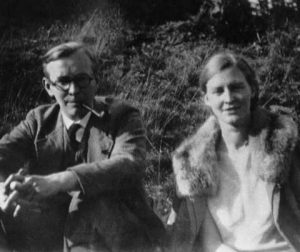 alarmed by Hitler’s rise to power, began to communicate with a close circle of associates who believed communism and the Soviet Union might be the only possible stumbling block to complete Nazi tyranny in Europe. As the Hitler and the Nazi regime began to come into power, Fish-Harnack and her husband joined a small resistance group, which the Nazi secret police…the Gestapo…would later call the Red Orchestra. This resistance group smuggled important secrets about the Nazis to the United States and Soviet governments and helped Jews escape from Germany. When war was declared in 1941, she did not leave with other American expatriates.
alarmed by Hitler’s rise to power, began to communicate with a close circle of associates who believed communism and the Soviet Union might be the only possible stumbling block to complete Nazi tyranny in Europe. As the Hitler and the Nazi regime began to come into power, Fish-Harnack and her husband joined a small resistance group, which the Nazi secret police…the Gestapo…would later call the Red Orchestra. This resistance group smuggled important secrets about the Nazis to the United States and Soviet governments and helped Jews escape from Germany. When war was declared in 1941, she did not leave with other American expatriates.
Of course, their activities were espionage and would eventually cost them their lives. For his part, her husband,  Arvid was hanged in December 1942. Mildred was given a six year sentence, but Hitler refused to endorse her punishment and she was retried and condemned on February 16, 1943. She was beheaded by guillotine. Because of her connection to possible communist sympathies and post-war McCarthyism, her story is virtually unknown in the United States. She was the only American woman who was ever put to death on the direct order of Adolf Hitler for her involvement in the resistance movement. Her last words were, “And I have loved Germany so much.” In the Cold War years after World War II, Fish-Harnack’s name and legacy were not honored in the United States, because she and her husband were believed to have been connected with Communism. For a time they were hated by both of their home countries. Once the truth came out in 1986, that changed and Mildred Fish-Harnack Day was established in Wisconsin. It takes place every year on her birthday, September 16th.
Arvid was hanged in December 1942. Mildred was given a six year sentence, but Hitler refused to endorse her punishment and she was retried and condemned on February 16, 1943. She was beheaded by guillotine. Because of her connection to possible communist sympathies and post-war McCarthyism, her story is virtually unknown in the United States. She was the only American woman who was ever put to death on the direct order of Adolf Hitler for her involvement in the resistance movement. Her last words were, “And I have loved Germany so much.” In the Cold War years after World War II, Fish-Harnack’s name and legacy were not honored in the United States, because she and her husband were believed to have been connected with Communism. For a time they were hated by both of their home countries. Once the truth came out in 1986, that changed and Mildred Fish-Harnack Day was established in Wisconsin. It takes place every year on her birthday, September 16th.
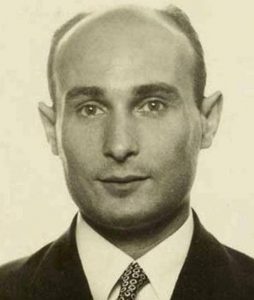 When someone sees something so horrific that the only think left to do is to act, drastic measures must be taken. Juan Pujol Garcia (aka Garbo), is one of the most successful intelligence agents in the annals of warfare. That is an amazing statement, but it is true. Garcia was a Spanish hotel manager who fiercely hated fascism and Germany. Garcia could see the horrific things that the Germans were doing, and he could not tolerate it. Garcia knew what he had to do, so he offered his services at the British embassy. Strangely, the British embassy staff laughed him out of the building, convincing the Spaniard the only way to impress the British was to infiltrate the German intelligence service, Abwehr.
When someone sees something so horrific that the only think left to do is to act, drastic measures must be taken. Juan Pujol Garcia (aka Garbo), is one of the most successful intelligence agents in the annals of warfare. That is an amazing statement, but it is true. Garcia was a Spanish hotel manager who fiercely hated fascism and Germany. Garcia could see the horrific things that the Germans were doing, and he could not tolerate it. Garcia knew what he had to do, so he offered his services at the British embassy. Strangely, the British embassy staff laughed him out of the building, convincing the Spaniard the only way to impress the British was to infiltrate the German intelligence service, Abwehr.
Without the help of the British government, Garcia decided that he had to take matters into his own hands. He headed to Lisbon, involved himself in the intrigue of the Portuguese capital, and was soon sending Abwehr a stream of bogus intelligence supposedly gleaned while traveling through Britain. In truth, he never left Lisbon, and was concocting information from films, newspapers, and even phone books. It was a drastic plan, but the stream of information earned him the trust of the Germans, and the British government finally gave Garcia 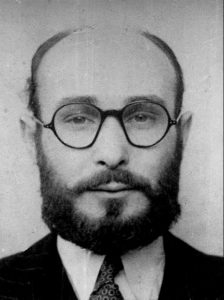 some missions. With this success to his credit, he talked his way into an interview in Britain with MI5. He was given the code name Garbo, after actress Greta Garbo, for his ability to spin convincing narratives out of thin air, and was put to work sending credible disinformation to the Germans.
some missions. With this success to his credit, he talked his way into an interview in Britain with MI5. He was given the code name Garbo, after actress Greta Garbo, for his ability to spin convincing narratives out of thin air, and was put to work sending credible disinformation to the Germans.
Now under cover, Garbo’s crowning achievement was his involvement in the operation to deceive the Nazis about the location of the Normandy invasion. He not only mislead the German high command about the location, but convinced them the D-Day landing was a diversion for an attack elsewhere. Garcia was such an important asset to the Nazis…or so they thought. The Germans even awarded him the Iron Cross, Second Class in July 1944. He also received the MBE from the British in November 1944. He had been a very successful double agent. After the war, Garbo deliberately faded into obscurity, fearing Nazi reprisals, and relocated to Venezuela, where he died in 1988.
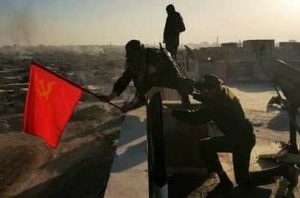 The ending of a war, does not always mean the beginning of peace, or even the end of fighting. Those who lost, don’t usually like the fact that they lost. As World War I drew to a close, angry rebels in both Germany and Austria-Hungary carried out a revolt on November 3, 1918, raising the red banner of the revolutionary socialist Communist Party and threatening to follow the Russian example in bringing down their imperialist governments.
The ending of a war, does not always mean the beginning of peace, or even the end of fighting. Those who lost, don’t usually like the fact that they lost. As World War I drew to a close, angry rebels in both Germany and Austria-Hungary carried out a revolt on November 3, 1918, raising the red banner of the revolutionary socialist Communist Party and threatening to follow the Russian example in bringing down their imperialist governments.
By the last week of October 1918, three of the Central Powers…Germany, Austria-Hungary, and the Ottoman Empire…were in talks with the Allies about reaching an armistice, while the fourth, Bulgaria, had concluded talks in September. On October 28, approximately 1,000 sailors in the German navy were arrested because they refused to follow orders from their commanders to launch a last-ditch attack against the British in the North Sea.
The rebels soon immobilized the German fleet. Then, the resistance spread to the German city of Kiel, where some 3,000 sailors and workers raised the red flag of communism on November 3. Admiral Wilhelm Souchon, the governor of Kiel, quickly called on naval officers who were loyal to the government to suppress the revolt. During the ensuing battle, eight rebels were killed, but the general resistance continued.
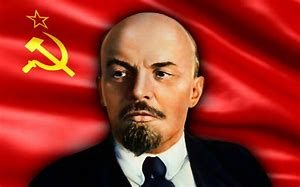 Meanwhile, the revolution was spreading in Vienna, as well as in Budapest, where the former Hungarian prime minister, Count Istvan Tisza, was assassinated by members of the communist-led Red Guard on October 31. By now, the empire was in shambles, so the Austro-Hungarian government secured an armistice with the Allied powers on November 3rd, ending its participation in World War I. That same day in Moscow, at a mass rally in support of the Austrian rebels, the communist leader Vladimir Lenin declared triumphantly: “The time is near when the first day of the world revolution will be celebrated everywhere.” It seems that evil will try to reincarnate, wherever it can find a group sympathetic to its cause.
Meanwhile, the revolution was spreading in Vienna, as well as in Budapest, where the former Hungarian prime minister, Count Istvan Tisza, was assassinated by members of the communist-led Red Guard on October 31. By now, the empire was in shambles, so the Austro-Hungarian government secured an armistice with the Allied powers on November 3rd, ending its participation in World War I. That same day in Moscow, at a mass rally in support of the Austrian rebels, the communist leader Vladimir Lenin declared triumphantly: “The time is near when the first day of the world revolution will be celebrated everywhere.” It seems that evil will try to reincarnate, wherever it can find a group sympathetic to its cause.
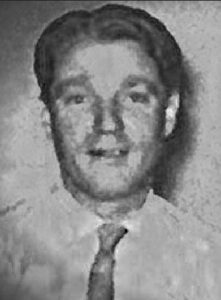 Most people have heard of, and seen, the James Bond movies. Of course, Bond is a fictional British agent, known as 007, and his character has been played by a number of actors over the years, but in reality, he is fictional. Renato Levi, who was also known as CHEESE, MR. ROSE, LAMBERT, EMILE, or ROBERTO, was a Jewish-Italian adventurer and double-agent for the British in World War II. Levi was instrumental in setting up a wireless transmitter in Cairo. The transmitter fed false information to the Axis powers over the course of the war. It was a great tool for the Allies. Unfortunately, Levi was captured and imprisoned shortly after he accomplished his mission. Levi’s “CHEESE” network helped to outflank Rommel at the battle of El Alamein in Egypt, as well as placing other, strategic misinformation that aided the Allies, including at Normandy.
Most people have heard of, and seen, the James Bond movies. Of course, Bond is a fictional British agent, known as 007, and his character has been played by a number of actors over the years, but in reality, he is fictional. Renato Levi, who was also known as CHEESE, MR. ROSE, LAMBERT, EMILE, or ROBERTO, was a Jewish-Italian adventurer and double-agent for the British in World War II. Levi was instrumental in setting up a wireless transmitter in Cairo. The transmitter fed false information to the Axis powers over the course of the war. It was a great tool for the Allies. Unfortunately, Levi was captured and imprisoned shortly after he accomplished his mission. Levi’s “CHEESE” network helped to outflank Rommel at the battle of El Alamein in Egypt, as well as placing other, strategic misinformation that aided the Allies, including at Normandy.
Levi almost always flew under the radar, especially in the British National Archives. Even in recent books about spies and counter-intelligence, the accomplishments of Renato Levi still receive barely a mention and the specifics about his part in all this is often confused. In all reality, Levi’s files have only recently been released, and even then Levi’s, aliases “Cheese,” “Lambert,” or “Mr. Rose” seem to be identified openly only once in his classified dossier. Indeed, in his national documents, there is evidence of redaction everywhere, including Levi’s primary codename “CHEESE” has been carefully handwritten in tiny, blocky letters over white-out, in order to re-establish a place in history.
The CHEESE network, out of Cairo, took a significant hit to its credibility when Levi was arrested and convicted in late 1941 or early 1942. The British came up with an imaginary agent. “Paul Nicossof” was able to regain and retain the trust of the Germans, which is one of the most interesting features of this story. Thanks to the expert manipulations of the British Intelligence operatives controlling the wireless, the CHEESE network was considered credible again by June of 1942…just in time for “A” Force to start planting counter-intelligence prior to the commencement of Operation Bertram at El Alamein in Egypt during October of 1942.
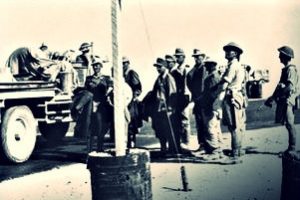 Most interesting to note are the ways that the intelligence operatives used payment schedules…or, rather, the German’s lack of payment to “Paul Nicossof”…to establish credibility about the fictitious informant’s information. “Nicossof” was portrayed as moody and inconsistent, because efforts to pay him were always unsuccessful. His “handlers” credited Germany’s inability to pay “Nicossof” as the way they were able to extend his character beyond the “impasse” that would normally constitute a non-military informant. “Nicossof” could portray himself as the “man who brought Rommel to Egypt,” which would get him paid for his troubles at last, as well as the glory and medals that went with it…all to a fictitious agent!!
Most interesting to note are the ways that the intelligence operatives used payment schedules…or, rather, the German’s lack of payment to “Paul Nicossof”…to establish credibility about the fictitious informant’s information. “Nicossof” was portrayed as moody and inconsistent, because efforts to pay him were always unsuccessful. His “handlers” credited Germany’s inability to pay “Nicossof” as the way they were able to extend his character beyond the “impasse” that would normally constitute a non-military informant. “Nicossof” could portray himself as the “man who brought Rommel to Egypt,” which would get him paid for his troubles at last, as well as the glory and medals that went with it…all to a fictitious agent!!
Perhaps because of the British Intelligence’s efforts to make “Nicossof” convincing and because Levi was so good under duress in prison, the Germans never really lost faith in the CHEESE operative network. They were starved for information, and CHEESE held the only promise for any intelligence about the Middle East. The Germans blamed the Italians for the confinement of their only key agent in the Middle East, Renato Levi. For whatever the reason, the Germans trusted Levi, but he never broke or compromised his duty to the Allied forces.
After looking at these newly declassified documents some people have tried to press Levi into the service of a “Hero Spy” figure, but in reality, Levi was a far more complicated figure and these whitewashed narratives don’t really tell the whole story of Levi’s complexity, nor the complexity of his work. Levi’s story also reveals much about the inner workings of the German Abwehr and the nature of the Italian Intelligence operations. Levi’s British handlers speculated that it was unlikely that the German and Italian Intelligence bureaus had a great deal of communication between them. The Germans were really overly satisfied with Levi’s original purpose of  establishing a wireless transmitter network, to their detriment in the end.
establishing a wireless transmitter network, to their detriment in the end.
It seems that Levi’s ultimate fate is unknown. It is true that the CHEESE network was in full swing throughout the war, and many have credited “CHEESE” with hoodwinking the Germans in a big way on many occasions. Perhaps Levi was again affiliated with CHEESE after his release, or maybe not. Regardless, Renato Levi, who had always loved travel, intrigue, and a really good lie, did a remarkable service to the Allied forces by instituting one of the best and most productive counter-intelligence operations of World War II, and he kept it all safe.
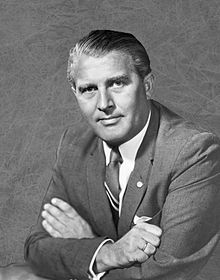 There is good that comes from science, and there is bad too, unfortunately. Things like weapons of warfare would most likely fall into the bad that comes from science. Still, weapons are necessary, and maybe it isn’t the weapon that is bad, but rather the user. Wernher von Braun was a rocket scientist in Hitler’s Germany. His job was to build bigger and more dangerous weapons. The V-2 missile was the culmination of von Braun’s work so far. On October 3, 1942, von Braun tested the V-2 missile. The missile was fired successfully from Peenemunde, as island off Germany’s Baltic coast. It traveled 118 miles in that test; and later, in evil weapon style, it proved extraordinarily deadly in the war. The V-2 missile was the precursor to the Intercontinental Ballistic Missiles (ICBMs) of the postwar era.
There is good that comes from science, and there is bad too, unfortunately. Things like weapons of warfare would most likely fall into the bad that comes from science. Still, weapons are necessary, and maybe it isn’t the weapon that is bad, but rather the user. Wernher von Braun was a rocket scientist in Hitler’s Germany. His job was to build bigger and more dangerous weapons. The V-2 missile was the culmination of von Braun’s work so far. On October 3, 1942, von Braun tested the V-2 missile. The missile was fired successfully from Peenemunde, as island off Germany’s Baltic coast. It traveled 118 miles in that test; and later, in evil weapon style, it proved extraordinarily deadly in the war. The V-2 missile was the precursor to the Intercontinental Ballistic Missiles (ICBMs) of the postwar era.
German scientists, led by von Braun, had been working on the development of these long-range missiles since the 1930s. I don’t know if von Braun was doing this work by choice, which would make him very likely as evil as the weapons of destruction he made, or whether, like so many of the German people under Hitler’s evil rule, he simply had no say in the matter. Whatever the case may be, von Braun was good at what he did. The science, which clearly must have fascinated him, was a work to which he was well suited. He understood it. He knew how to make it do hat he wanted it to do, and become what he wanted it to become…or, at least what he was told to make it become. Still, it took time to perfect. Three trial launches had already failed. The fourth in the series, known as A-4,  finally saw the V-2, a 12-ton rocket capable of carrying a one-ton warhead, successfully launched. I wonder just how much pressure was on von Braun at that fourth launch attempt. Could it have cost him his life, or his freedom, if he did not successfully create this weapon that Hitler wanted so badly.
finally saw the V-2, a 12-ton rocket capable of carrying a one-ton warhead, successfully launched. I wonder just how much pressure was on von Braun at that fourth launch attempt. Could it have cost him his life, or his freedom, if he did not successfully create this weapon that Hitler wanted so badly.
The V-2 was unique in several ways. First, it was virtually impossible to intercept, making it a serious threat to anyone it was aimed at. Upon launching, the missile rises six miles straight up. Then, it proceeds on an arced course, cutting off its own fuel according to the range desired. The missile then tips over and falls on its target-at a speed of almost 4,000 miles per hour. That would make it extremely difficult to blow up in flight, since hitting something moving at that speed would take serious accuracy, and heat seeking missiles were not developed yet. The missile hits with such force that it burrows itself several feet into the ground before exploding. In addition, the missile had the potential of flying a distance of 200 miles, and the launch pads were portable, making them impossible to detect before firing.
September 6, 1944 became the first real use of the V-2, when two missiles were fired at Paris. On September 8, two more were fired at England, which would be followed by more than 1,100 more during the next six months. More than 2,700 British citizens died because of the rocket attacks. After the war, both the United States and the Soviet Union captured samples of the rockets for reproduction. They also captured the scientists  responsible for their creation. Following the war, von Braun was secretly moved to the United States, along with about 1,600 other German scientists, engineers, and technicians, as part of Operation Paperclip. He worked for the United States Army on an intermediate-range ballistic missile program, and he developed the rockets that launched the United States’ first space satellite Explorer 1.
responsible for their creation. Following the war, von Braun was secretly moved to the United States, along with about 1,600 other German scientists, engineers, and technicians, as part of Operation Paperclip. He worked for the United States Army on an intermediate-range ballistic missile program, and he developed the rockets that launched the United States’ first space satellite Explorer 1.
His group was assimilated into NASA, where he served as director of the newly formed Marshall Space Flight Center and as the chief architect of the Saturn V super heavy-lift launch vehicle that propelled the Apollo spacecraft to the Moon. He also advocated for a human mission to Mars. In 1967, von Braun was inducted into the National Academy of Engineering and in 1975, he received the National Medal of Science. Von Braun died on June 16, 1977 of pancreatic cancer in Alexandria, Virginia at age 65. He was buried at the Ivy Hill Cemetery. His gravestone quotes Psalm 19:1: “The heavens declare the glory of God; and the firmament sheweth his handywork” (KJV).
 Every time I learn anything about Adolf Hitler, I am stunned that so much evil could exist in one man. World War II technically started when Adolf Hitler invaded Poland. Hitler told his men that “it did not matter who was right or wrong, that in fighting a war, coming out triumphant is the only thing that counted.” He urged his men to have no sympathy for their opponent. On September 1, 1939, Hitler ordered the invasion of Poland, by ordering the attack of defenseless civilians. In this way, they put the citizens in a state of shock. The sky was dark and there were dead bodies everywhere. Once Germany invaded Poland, it opened a door to allow the Soviets to also invade Poland. Of course, this was not exactly what either country wanted.
Every time I learn anything about Adolf Hitler, I am stunned that so much evil could exist in one man. World War II technically started when Adolf Hitler invaded Poland. Hitler told his men that “it did not matter who was right or wrong, that in fighting a war, coming out triumphant is the only thing that counted.” He urged his men to have no sympathy for their opponent. On September 1, 1939, Hitler ordered the invasion of Poland, by ordering the attack of defenseless civilians. In this way, they put the citizens in a state of shock. The sky was dark and there were dead bodies everywhere. Once Germany invaded Poland, it opened a door to allow the Soviets to also invade Poland. Of course, this was not exactly what either country wanted.
Before the end of the month, on September 29, 1939, Germany and the Soviet Union agree to divide control of occupied Poland roughly along the Bug River, with the Germans taking everything west, and the Soviets taking everything east. The people of Poland were given away like slaves. In addition, as a follow-up to the Molotov-Ribbentrop Pact, which was also known as the Hitler-Stalin Pact, a non-aggression treaty was created between the two huge military powers of Germany and the USSR. The German foreign minister, Joachim von Ribbentrop met with his Soviet counterpart, VM Molotov, to sign the German-Soviet Boundary and Friendship Treaty. Of course, the “friendship” did not extend to the Polish people.
As in normal in any contract, there was “fine print” in this agreement too. The fine print of the original non-aggression pact had promised the Soviets a slice of eastern Poland. It was to be a small part, simply a matter of agreeing where to draw the lines. Joseph Stalin, Soviet premier and dictator, personally drew the line that partitioned Poland. He originally wanted it drawn at the River Vistula, just west of Warsaw. In the end, he agreed to pull it back east of the capital and Lublin, giving Germany control of most of Poland’s most heavily populated and industrialized regions. In exchange, Stalin wanted Lvov, and its rich oil wells, and Lithuania, which sits atop East Prussia. Germany was fine with that, because now they had 22 million Poles, “slaves of the Greater German Empire,” at its disposal…and Russia had a western buffer zone.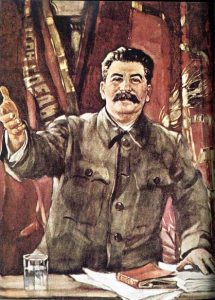
On this same day, the Soviet Union also signed a Treaty of Mutual Assistance with the Baltic nation of Estonia, giving Stalin the right to occupy Estonian naval and air bases. What was thought to be a buffer zone, seems more like a land grab to me. A similar treaty would later be signed with Latvia. These nations really didn’t seem to realize what they were getting into. Eventually, Soviet tanks rolled across these borders, in the name of “mutual assistance,” placing the Baltic States under the rule of the USSR for decades to come. These so called treaties were once again merely the realization of more fine print from the Ribbentrop-Molotov Pact, giving Stalin more border states as buffer zones, and protecting Russian territory where the Bolshevik ideology had not been enthusiastically embraced from intrusion by its western neighbor, namely its non-aggression partner Germany. The highly vulnerable Baltic nations had no say in any of these arrangements. They were merely annexed…by force in a huge Soviet land grab.
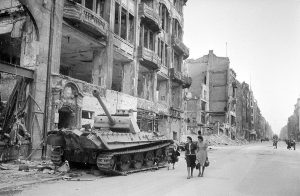 World War II took it’s toll on many people. The soldiers, families at home, and probably unknown to the people of the Allied nations…the German people. When we think of the Nazis, we think of an entire country so filled with hate for the Jewish people…as well as any nationality that was different that the Nazi white people. The reality is that while there were a relatively small number of Hitler’s puppets to actually embraced the thinking and the hatred of Hitler; there were also a great many of the German people who were not Nazis, nor did they agree with anything that Hitler did or believed. They were good and decent people, who valued life, and just wanted to work hard, and live their lives in peace and happiness.
World War II took it’s toll on many people. The soldiers, families at home, and probably unknown to the people of the Allied nations…the German people. When we think of the Nazis, we think of an entire country so filled with hate for the Jewish people…as well as any nationality that was different that the Nazi white people. The reality is that while there were a relatively small number of Hitler’s puppets to actually embraced the thinking and the hatred of Hitler; there were also a great many of the German people who were not Nazis, nor did they agree with anything that Hitler did or believed. They were good and decent people, who valued life, and just wanted to work hard, and live their lives in peace and happiness.
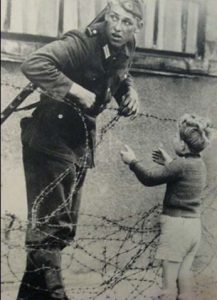
These post-war German citizens were faced with a new and strange kind of post-war reality. The country suffered from collective PTSD. Said one German citizen, “We were a broken, defeated, extinguished people in 1045. 60 million human beings suffered from PTDS. And Knowing that not only did you lose…but also that you were on the wrong side. On the wrong side of morality, of humanity, of history. We were the bad guys. There was no pride. Just the knowledge that we were at rock bottom, and rightfully so.”
As American and Allies, it is hard for us to accept their feelings of remorse. I’m sure that the Jews, Gypsies, and other persecuted races had an even harder time feeling bad for the German people…at least, not unless they were some of the German citizens who escaped from Germany along with other refugees, or those who helped their Jewish or Gypsy counterparts to escape or to survive. One of those sympathizers who lived, warned his children and grandchildren, saying, “Don’t forget, but don’t tell anyone about this.” He was so ashamed and so angry, still, 40, 50 years 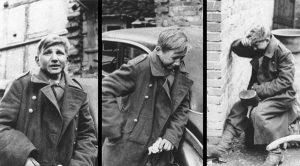 later. He said that the Nazis had taken the best years of his life, saying, “We must look out for them, it can happen again. Beware, pay attention to politics! Speak up! We couldn’t stop them, maybe you can, next time.” The man hammered these things into his grandchild’s brain, over and over and over. He knew the dangers of complacency where politics is concerned. He knew that if they take your guns you are helpless. He knew that if evil people get in office, the danger grows exponentially. He had seen it…first hand. It is a lesson many people today need to learn. It could happen again, if we aren’t vigilant.
later. He said that the Nazis had taken the best years of his life, saying, “We must look out for them, it can happen again. Beware, pay attention to politics! Speak up! We couldn’t stop them, maybe you can, next time.” The man hammered these things into his grandchild’s brain, over and over and over. He knew the dangers of complacency where politics is concerned. He knew that if they take your guns you are helpless. He knew that if evil people get in office, the danger grows exponentially. He had seen it…first hand. It is a lesson many people today need to learn. It could happen again, if we aren’t vigilant.
 Most people know what a blimp is. It is an airship, but not the first airship. Most people have also heard of the Hindenburg…a airship than exploded causing an horrific crash. While one airship is loved by all who see it, and one met a horrible end, yet another airship brought fear to many. The third airship…a Zeppelin, which is a type of rigid airship named after the German Count Ferdinand von Zeppelin who pioneered rigid airship development at the beginning of the 20th century, was used at one time as a bomber.
Most people know what a blimp is. It is an airship, but not the first airship. Most people have also heard of the Hindenburg…a airship than exploded causing an horrific crash. While one airship is loved by all who see it, and one met a horrible end, yet another airship brought fear to many. The third airship…a Zeppelin, which is a type of rigid airship named after the German Count Ferdinand von Zeppelin who pioneered rigid airship development at the beginning of the 20th century, was used at one time as a bomber.
Zeppelin’s notions were first formulated in 1874 and developed in detail in 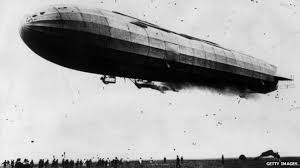 1893. When they were built, they were patented in Germany in 1895 and in the United States in 1899, as commercial passenger airships. The airship design was an outstanding success, and the word zeppelin is often used to refer to all rigid airships. Zeppelins were first flown commercially in 1910 by Deutsche Luftschiffahrts-AG (DELAG), the world’s first airline in revenue service. By mid-1914, DELAG had carried over 10,000 fare-paying passengers on over 1,500 flights. Those were the good years of its use.
1893. When they were built, they were patented in Germany in 1895 and in the United States in 1899, as commercial passenger airships. The airship design was an outstanding success, and the word zeppelin is often used to refer to all rigid airships. Zeppelins were first flown commercially in 1910 by Deutsche Luftschiffahrts-AG (DELAG), the world’s first airline in revenue service. By mid-1914, DELAG had carried over 10,000 fare-paying passengers on over 1,500 flights. Those were the good years of its use.
During World War I, the German military found a new use for the Zeppelins. They were used as bombers and scouts. The new Zeppelins brought terror to the people. During their use, the Zeppelins were used to kill over 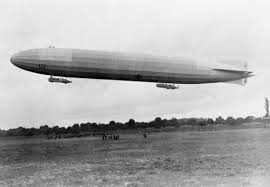 500 people in bombing raids in Britain. The new type of bomber didn’t, however, bring victory to Germany in World War I. When you think about it, how could an airship, like the Zeppelin make a good fighting aircraft. Its very design was far too vulnerable to any kind of bullet. I suppose that it was thought that there wouldn’t be many other “bombers” in the sky, but that doesn’t make the Zeppelin a safe bomber in any way. Nevertheless…safe, effective, accurate, or not…the Zeppelin worked as a bomber for a time. Unusual as it was, the slow-moving…about 84 miles per hour…airship had the distinct honor of being a bomber in World War I.
500 people in bombing raids in Britain. The new type of bomber didn’t, however, bring victory to Germany in World War I. When you think about it, how could an airship, like the Zeppelin make a good fighting aircraft. Its very design was far too vulnerable to any kind of bullet. I suppose that it was thought that there wouldn’t be many other “bombers” in the sky, but that doesn’t make the Zeppelin a safe bomber in any way. Nevertheless…safe, effective, accurate, or not…the Zeppelin worked as a bomber for a time. Unusual as it was, the slow-moving…about 84 miles per hour…airship had the distinct honor of being a bomber in World War I.
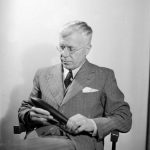
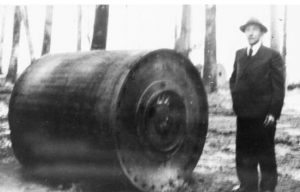 We have all tried our hand at skipping stones across the water, but who would have thought that such an idea could be applied to a bomb, or that it would ultimately become extremely successful in accomplishing its given task…destroying German dams and hydroelectric plants along the Ruhr valley.
We have all tried our hand at skipping stones across the water, but who would have thought that such an idea could be applied to a bomb, or that it would ultimately become extremely successful in accomplishing its given task…destroying German dams and hydroelectric plants along the Ruhr valley.
During World War II, the Allies we’re desperate to cut off energy to the Nazi war machine, so the Allied engineers were given the task of finding a way to breach the defenses surrounding the dams and hydroelectric plants. In the end, it was British engineer, Barnes Wallis who came through with what he called “bouncing bombs.” To watch it in action, one is reminded of skipping stones like most of us have done in the past. In similar fashion, the bomb skips along the water bouncing over the torpedo nets to hit its target.
When World War II began, Germany had the undisputed upper hand when it came to water-based warfare with 
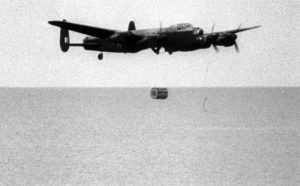 their deadly U-boats and defensive “torpedo nets” placed strategically in front of their energy-creating dams. This made it next to impossible to hit the dams with the traditional torpedo. The British Royal Air Force was determined to take out these German battlements, as they slowly wore the Axis of Evil down.
their deadly U-boats and defensive “torpedo nets” placed strategically in front of their energy-creating dams. This made it next to impossible to hit the dams with the traditional torpedo. The British Royal Air Force was determined to take out these German battlements, as they slowly wore the Axis of Evil down.
The problem was, how to somehow get past the torpedo nets, to destroy the dams and their hydroelectric plants. Wallis had to figure out how to bypass the torpedo nets, in order to make direct contact with the wall of the dams. It seemed like an insurmountable task. After dwelling on the problem for a while, Wallis seized on 
 the potential of the Magnus effect, which would bounce a bomb across the water like a skipping stone.
the potential of the Magnus effect, which would bounce a bomb across the water like a skipping stone.
The theory was to create backspin, which would counter the gravity and send the bomb skimming over the water. Once it bounced over the torpedo net, it hit the designated target. The plan seemed plausible, and the Royal Air Force commenced Operation Chastise on May 16, 1943. The results were spectacular!! As it turned out, Barnes Wallis really knew his stuff.
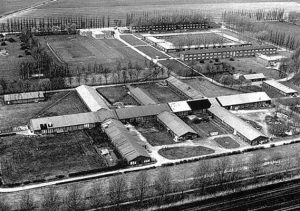 The Neuengamme concentration camp was established in December 1938, and used by the Nazis as a forced labor camp from December 13, 1938 to May 4, 1945, when it was liberated by British troops. At the time of its liberation, about half of the approximately 106,000 Jews held there over time had died. Neuengamme was located on the Elbe river, near Hamburg, Germany. One hundred inmates who were transferred from Sachsenhausen concentration camp, were forced to build the Neuengamme concentration camp. It was established around an empty brickworks in Hamburg-Neuengamme. The bricks produced there were to be used for the “Fuehrer buildings” part of the National Socialists’ redevelopment plans for the river Elbe in Hamburg.
The Neuengamme concentration camp was established in December 1938, and used by the Nazis as a forced labor camp from December 13, 1938 to May 4, 1945, when it was liberated by British troops. At the time of its liberation, about half of the approximately 106,000 Jews held there over time had died. Neuengamme was located on the Elbe river, near Hamburg, Germany. One hundred inmates who were transferred from Sachsenhausen concentration camp, were forced to build the Neuengamme concentration camp. It was established around an empty brickworks in Hamburg-Neuengamme. The bricks produced there were to be used for the “Fuehrer buildings” part of the National Socialists’ redevelopment plans for the river Elbe in Hamburg.
The prisoners worked on the construction of the camp and brickmaking. The bricks were used for regulating the flow of the Dove-Elbe river and the building of a branch canal. The prisoners were also 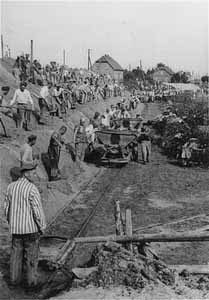 used to mine the clay used to make the bricks. That reminds me of the Jews in Egypt who were forced to build the pyramids. In 1940, the population of the camp was 2,000 prisoners, with a proportion of 80% German inmates among them. Between 1940 and 1945, more than 95,000 prisoners were incarcerated in Neuengamme. On April 10th, 1945, the number of prisoners in the camp itself was 13,500. Over the years that Neuengamme was open, it is estimated that 103,000 to 106,000 people were held there. We may never really know, because they didn’t keep clear records of all the people who went through the camps.
used to mine the clay used to make the bricks. That reminds me of the Jews in Egypt who were forced to build the pyramids. In 1940, the population of the camp was 2,000 prisoners, with a proportion of 80% German inmates among them. Between 1940 and 1945, more than 95,000 prisoners were incarcerated in Neuengamme. On April 10th, 1945, the number of prisoners in the camp itself was 13,500. Over the years that Neuengamme was open, it is estimated that 103,000 to 106,000 people were held there. We may never really know, because they didn’t keep clear records of all the people who went through the camps.
From 1942 on, the inmates were forced to work in the Nazi armament production. At first, the work was performed in the Neuengamme workshops, but soon it was decided to transfer the prisoners to the armaments factories in the surroundings areas. At the end of the war, the prisoners of Neuengamme were spread all over northern Germany. As the Allied troops advanced, hundreds of inmates were forced to dig antitank ditches. In many large north German cities, The prisoners were also require to clear rubble and removed corpses after bombing raids. There were 96 sub-camps, 20 of them for women. In early spring 1945, more than 45,000 inmates were working for the Nazi industry. A third of the women were forced to be among a part of the Nazi 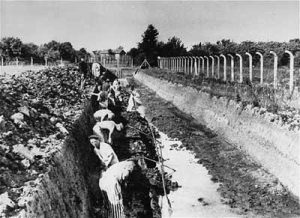 industry workforce. By this time, the internal population of Neuengamme was 13,500, which made it completely overcrowded. The estimated number of victims in Neuengamme is approximately 56,000. Thousands of inmates were hanged, shot, gassed, killed by lethal injection or transferred to the death camps Auschwitz and Majdanek. As the war neared its end, the SS decided to evacuate Neuengamme. They had hoped to avoid having them liberated…probably hoping to regroup further north. This was the start of one of the worst death marches of the war. During these death marches, approximately 10,000 inmates perished by shootings or simply starvation. Nevertheless, the Allies won this war, and then they went in and liberated the prisoners of the many death camp.
industry workforce. By this time, the internal population of Neuengamme was 13,500, which made it completely overcrowded. The estimated number of victims in Neuengamme is approximately 56,000. Thousands of inmates were hanged, shot, gassed, killed by lethal injection or transferred to the death camps Auschwitz and Majdanek. As the war neared its end, the SS decided to evacuate Neuengamme. They had hoped to avoid having them liberated…probably hoping to regroup further north. This was the start of one of the worst death marches of the war. During these death marches, approximately 10,000 inmates perished by shootings or simply starvation. Nevertheless, the Allies won this war, and then they went in and liberated the prisoners of the many death camp.

